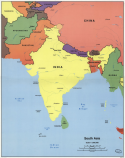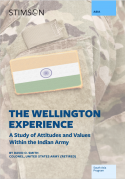2/2
Although the Chinese military and economy continued to grow at a rapid pace,
the 2005 Student did not perceive that China was regarded as the main threat to India.
The Indian students, he explained, had less respect for the military professionalism and competence of China’s People’s Liberation Army (PLA) than for the Pakistan Army. They had more respect for China’s growing naval power projection capability. The major joint exercise at the DSSC that year was an amphibious operation to regain the Andaman Islands that had been seized by Chandol. Because Indian Army doctrine was largely based on a quantitative assessment of resources, any land war with China meant the sheer numbers of the PLA merited respect. As the first decade of the new century ended, the threat from Pakistan remained “real and visceral” to most of his classmates, while the threat from China was not perceived to be as great, and certainly was not existential. He added that the old Nehruvian slogan of Hindi Chini bhai (“India and China are brothers”) continued to resonate with many students.
The 2007 Student A discerned a degree of symbiosis: both India and China were reaping the benefits of economic reforms, there was a burgeoning trade relationship between them, and everyone had great confidence that the lingering border dispute could be managed without conflict. It was not until 2011 that China clearly began to be perceived by all three groups at the DSSC as “India’s biggest threat.”
The 2011 Student A n
oted that few of his classmates had ever had any interaction with Chinese people, and that Chinese behavior puzzled them. He also had difficulty understanding why India was so preoccupied with China’s conventional military capability when the avenues of approach into India led across the enormous Tibetan plateau and through the rugged Himalayan Mountains. He did notice, however, a growing concern about the prospect of a two-front war with Pakistan and China that might expand into a three-front situation if the Chinese Navy continued to grow, modernize, and operate in strength in the Indian Ocean. Still, there remained a curious reluctance to declare that China was an “enemy” of India, with many students still preferring to label it merely a “competitor.”
There was a lot of discussion about various Chinese regional stratagems like the “string of pearls,” in which China was seeking to build or gain access to ports along the Indian Ocean sea frontier, and the Belt and Road Initiative projects designed to enhance Chinese economic power throughout Asia. The major challenge for the Indian armed forces seemed to lie in the maritime domain, and the strategy required was a combination of naval modernization and new shipbuilding. Apparently not to be outdone by the navy, the army was beginning to modify its ground forces doctrine along the northern border from the traditional “defensive attrition model” to one that featured the rapid forward movement of offensive forces, the apparent objective being to take the offensive early against any Chinese ground incursion. To this end, it was in the process of modernizing artillery and creating a rapid-response airborne regiment. Also in 2011, a new reference book on China was issued to DSSC students.
As may be seen in the extracts below from a section titled “Indian Perception of China,” it laid out a curiously ambivalent assessment of the threat to India posed by China: India has a strategic and cooperative partnership with the People’s Republic of China which has been further progressed during high level visits in 2009-10. The two countries are seeking to build a relationship of friendship and trust, based on equality, in which each is sensitive to the concerns and aspirations of the other. However, at one extreme are some who see China as incorrigibly aggressive and expansionist, posing a perennial threat to India. At the other extreme are those who perceive it as a benign neighbour and an ancient civilisation that has been exploited in the past. But, the majority of Indians seem to carry in their minds a more mixed picture, with both positive and negative ingredients. The irritants that constantly plague Sino-Indian relations are as under: - (a) Boundary dispute. (b) Dalai Lama issue. (c) China’s assistance to Pakistan’s Missile and Nuclear weapon programme. … As far as India is concerned, it cannot be ignored that every major Indian city is within reach of Chinese missiles and this capability is being further augmented to include Submarine Launched Ballistic Missiles (SLBMs). … The armed forces of both the nations are engaged in building greater understanding through joint military exercises, regular defence dialogues since 2007 and exchange of military delegations. India has obviously taken note of
China’s statement in the White Paper on China’s National Defence in 2008 that it will never seek hegemony or engage in military expansion now or in future.
Meanwhile India has also taken note of the double digit growth in Chinese defence expenditures over the previous 20 years, which has led to significant modernisation of its armed forces, both in terms of quality and quantity. In the same White Paper, China stated its objective to develop strategic missiles and space based assets, enhance its blue water capabilities for the navy and upgrade infrastructure, reconnaissance, surveillance and quick response capabilities in the border areas. India believes that this will affect the overall military environment in the neighbourhood of India and hence it needs to monitor the defence modernisation of China carefully.195
The 2016 Student noted the absence of urgency in confronting China militarily either on land or at sea despite the fact that it was moving swiftly to build a capability to challenge India in many new areas and from several new directions. There was growing concern about Chinese success in establishing a permanent naval presence in the Indian Ocean by gaining guaranteed access to ports in Africa at Djibouti, in Pakistan at Gwadar, in Sri Lanka at Hambantota, and in Burma at Kyaukpyu. Although they were confident in being able to defeat the Pakistan Air Force in any future conflict, a few students expressed concern that China might provide Pakistan enough high-technology aircraft to offset India’s qualitative and quantitative edge over the PAF.
By now there was also no disputing the fact that India had been “left behind” in the past decade and was clearly behind China in most measures of economic and military power.
Now in the DSSC wargames, the China-like opponent was no longer Chandol, but “Yellowland” if the principal enemy was the Pakistan-like opponent and “Redland” if it was the only opponent. Shortly after the 2017 course ended, on June 16, China attempted to extend a road southward in Doklam, a territory claimed by both China and Bhutan. India was concerned that a road in this region might allow China to cut off Indian access to the northeastern states. Claiming to have acted on behalf of Bhutan, with which it has a “special relationship,” New Delhi moved troops into the area to prevent any further work on the road. After 73 tense days of face-to-face confrontation, the two sides agreed on August 28 to pull back more or less simultaneously. Prime Minister Modi subsequently visited China in September 2017 for a BRICS summit, and on the sidelines of the summit met with Chinese president Xi Jinping. The two agreed to reaffirm ties and carry forward an agreement made earlier that year that differences between them should not be allowed to become disputes.197 More recently, beginning in May 2020 and still ongoing at the time of this writing, have been a series of Chinese border incursions at multiple locations along the LAC in Ladakh in the eastern section of Jammu and Kashmir.
Ashley Tellis notes that these actions suggest a high degree of premeditation and top-level approval for the military’s activities that might be linked to India’s August 2019 decision to change the political status of Jammu and Kashmir. The current crisis also reveals, in his opinion, that China has scant respect for India’s efforts to freeze the status quo along the LAC or New Delhi’s attempts to avoid the appearance of collusion with the United States against Beijing. By treating New Delhi’s recent actions in Jammu and Kashmir as a provocation, China is now confronting India with the difficult choice of either accepting a new status quo on the LAC or escalating through force if the negotiations presently under way are unsuccessful.
The Diplomat article/interview:





